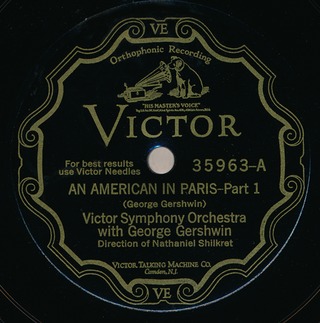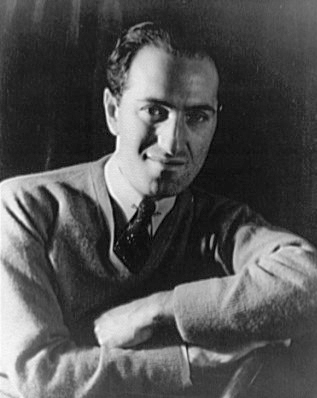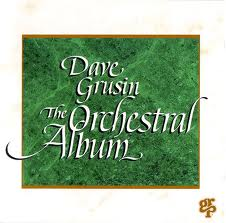Related Research Articles

An American in Paris is a jazz-influenced symphonic poem for orchestra by American composer George Gershwin first performed in 1928. It was inspired by the time that Gershwin had spent in Paris and evokes the sights and energy of the French capital during the Années folles.

George Gershwin was an American composer and pianist whose compositions spanned popular, jazz and classical genres. Among his best-known works are the orchestral compositions Rhapsody in Blue (1924) and An American in Paris (1928), the songs "Swanee" (1919) and "Fascinating Rhythm" (1924), the jazz standards "Embraceable You" (1928) and "I Got Rhythm" (1930), and the opera Porgy and Bess (1935), which included the hit "Summertime".

Rhapsody in Blue is a 1924 musical composition written by George Gershwin for solo piano and jazz band, which combines elements of classical music with jazz-influenced effects. Commissioned by bandleader Paul Whiteman, the work premiered in a concert titled "An Experiment in Modern Music" on February 12, 1924, in Aeolian Hall, New York City. Whiteman's band performed the rhapsody with Gershwin playing the piano. Whiteman's arranger Ferde Grofé orchestrated the rhapsody several times including the 1924 original scoring, the 1926 pit orchestra scoring, and the 1942 symphonic scoring.

Ferdinand Rudolph von Grofé, known as Ferde Grofé was an American composer, arranger, pianist, and instrumentalist. He is best known for his 1931 five-movement symphonic poem, Grand Canyon Suite, and for orchestrating George Gershwin's Rhapsody in Blue for its 1924 premiere.
The 19th Annual Grammy Awards were held on February 19, 1977, and were broadcast live on American television (CBS). It was the seventh and final year Andy Williams hosted the telecast. The ceremony recognized accomplishments by musicians from the year 1976.

Porgy and Bess is an English-language opera by American composer George Gershwin, with a libretto written by author DuBose Heyward and lyricist Ira Gershwin. It was adapted from Dorothy Heyward and DuBose Heyward's play Porgy, itself an adaptation of DuBose Heyward's 1925 novel Porgy.

Lorin Varencove Maazel was an American conductor, violinist and composer. He began conducting at the age of eight and by 1953 had decided to pursue a career in music. He had established a reputation in the concert halls of Europe by 1960 but, by comparison, his career in the U.S. progressed far more slowly. He served as music director of The Cleveland Orchestra, Orchestre National de France, Pittsburgh Symphony Orchestra, Bavarian Radio Symphony Orchestra, and the New York Philharmonic, among other posts. Maazel was well-regarded in baton technique and possessed a photographic memory for scores. Described as mercurial and forbidding in rehearsal, he mellowed in old age.

Robert Russell Bennett was an American composer and arranger, best known for his orchestration of many well-known Broadway and Hollywood musicals by other composers such as Irving Berlin, George Gershwin, Jerome Kern, Cole Porter, and Richard Rodgers.

William Steinberg was a German-American conductor.

Blue Monday was the original name of a one-act "jazz opera" by George Gershwin, renamed 135th Street during a later production. The English libretto was written by Buddy DeSylva. Though a short piece, with a running time of between twenty and thirty minutes, Blue Monday is often considered the blueprint to many of Gershwin's later works, and is often considered to be the "first piece of symphonic jazz" in that it was the first significant attempt to fuse forms of classical music such as opera with American popular music, with the opera largely influenced by Jazz and the African-American culture of Harlem.
Porgy and Bess, the opera by George Gershwin, has been recorded by a variety of artists since it was completed in 1935, including renditions by jazz instrumentalists and vocalists, in addition to operatic treatments.
Porgy and Bess: A Symphonic Picture is a 1942 orchestral medley arranged by George Gershwin's good friend and sometimes assistant, Robert Russell Bennett, which includes most of the best-known songs from the Gershwin opera Porgy and Bess, although not in the exact order of their appearance. Though the Symphonic Picture is sometimes dismissed as a sequence of the opera's "greatest hits," the first well-known melody, "Summertime," is not heard until nearly seven minutes into the work. While some of the more esoteric parts of the opera are absent, many of the catchier tunes that can be heard in this suite are absent in others, including Gershwin's own Catfish Row Suite, which tended to highlight the more cerebral elements of the work.
This is the discography of Simon Rattle and other produced works by the English conductor.

Symphonic Dances, Op. 45, is an orchestral suite in three movements completed in October 1940 by Russian composer Sergei Rachmaninoff. It is his final major composition, and his only piece written in its entirety while living in the United States.
"I Loves You, Porgy" is a duet from the 1935 opera Porgy and Bess with music by George Gershwin and lyrics by Ira Gershwin. It was performed in the opera's premiere in 1935 and on Broadway the same year by Anne Brown and Todd Duncan. They recorded the song on volume 2 of the album Selections from George Gershwin's Folk Opera Porgy and Bess in 1942. The duet occurs in act 2, scene 3, Catfish Row, where Porgy promises Bess that he will protect her. Bess has a lover, Crown, who is abusive and continually seduces her.

Wayne Ea Marshall is a British pianist, organist, and conductor.
Marquita Lister is an American operatic soprano. She has sung with major companies in the U.S. and abroad, specializing in the lirico-spinto repertoire. Lister is considered one of the leading interpreters of Bess in Porgy and Bess, having performed the role hundreds of times in companies across the globe, and she is also renowned for her portrayals of Aida and Salome, two signature roles.

The Orchestral Album is an album by American pianist Dave Grusin released in 1994, recorded for GRP Records. It contains both original recordings and new arrangements of previously released material. The arrangement of Three Cowboy Songs won the 1995 Grammy Award for Best Instrumental Arrangement.
Camellia Johnson was an American concert and opera singer. She began her career performing works from the mezzo-soprano repertoire, but after encouragement from the staff at the Metropolitan Opera retrained her voice as a soprano. She successfully made that transition after winning the Young Concert Artists competition in 1993. She went on to perform as a leading soprano with orchestras and opera companies internationally.
References
- ↑ "New York Philharmonic - Scores > Gershwin, George" . Retrieved 27 October 2016.
- ↑ "George and Ira Gershwin Critical Edition". Archived from the original on 15 December 2018. Retrieved 27 October 2016.
- ↑ "New, critical edition of George and Ira Gershwin's works to be compiled" . Retrieved 27 October 2016.
- ↑ "Who Could Ask For Anything More". 8 September 2013. Retrieved 27 October 2016.
- ↑ "Gershwin: Rhapsody In Blue, Etc / Levine, Chicago ... - Deutsche Grammophon: 4316252 - Buy from ArkivMusic" . Retrieved 27 October 2016.
- ↑ "New York Philharmonic New Year's Eve: A Gershwin Celebration - Live From Lincoln Center". Archived from the original on 28 October 2016. Retrieved 27 October 2016.
- Ferencz, George J. “Porgy and Bess on the Concert Stage: Gershwin's 1936 Suite (“Catfish Row”) and the 1942 Gershwin–Bennett Symphonic Picture.” Musical Quarterly 94:1-2 (Spring-Summer 2011), 93-155.
- Jablonski, Edward. Gershwin: A Biography. Garden City, New Jersey: Doubleday & Company, 1987. ISBN 0-7924-2164-7
- Gershwin, George. "Suite from Porgy and Bess" (1936 "paste-up" holograph based upon pages photo-reproduced from his manuscript score for the opera). Box 49, Folder, 5, George Gershwin Collection, Music Division, Library of Congress.
- Liner Notes for Telarc 2CD-80445 (Erich Kunzel and the Cincinnati Pops Orchestra)